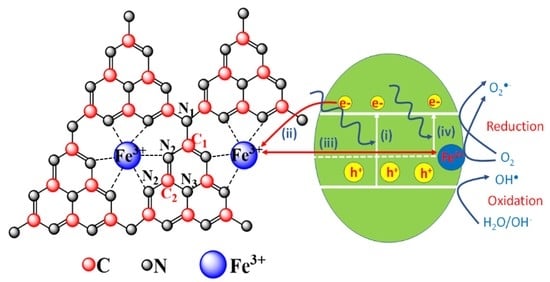Fe-Doped g-C3N4: High-Performance Photocatalysts in Rhodamine B Decomposition
Abstract
1. Introduction
2. Materials and Methods
2.1. Synthesis of g-C3N4 Nanosheets
2.2. Synthesis of Fe-dope g-C3N4 Nanosheets
2.3. Characterizations
2.4. Photocatalytic Process
3. Results and Discussions
3.1. Structural Property Analysis
3.2. Morphology Analysis
3.3. Optical Property Analysis
3.4. Chemical Composition Analysis
3.5. Photocatalytic Activity Analysis
4. Conclusions
Author Contributions
Funding
Conflicts of Interest
References
- Höök, M.; Tang, X. Depletion of Fossil Fuels and Anthropogenic Climate Change—A Review. Energy Policy 2013, 52, 797–809. [Google Scholar] [CrossRef]
- Capellán-Pérez, I.; Mediavilla, M.; de Castro, C.; Carpintero, Ó.; Miguel, L.J. Fossil Fuel Depletion and Socio-Economic Scenarios: An Integrated Approach. Energy 2014, 77, 641–666. [Google Scholar] [CrossRef]
- Abas, N.; Kalair, A.; Khan, N. Review of Fossil Fuels and Future Energy Technologies. Futures 2015, 69, 31–49. [Google Scholar] [CrossRef]
- Hoffmann, M.R.; Martin, S.T.; Choi, W.; Bahnemann, D.W. Environmental Applications of Semiconductor Photocatalysis. Chem. Rev. 1995, 95, 69–96. [Google Scholar] [CrossRef]
- Mills, A.; Hunte, S.L. An Overview of Semiconductor Photocatalysis. J. Photochem. Photobiol. A Chem. 1998, 108, 1–35. [Google Scholar] [CrossRef]
- Sharma, A.; Ahmad, J.; Flora, S.J.S. Application of Advanced Oxidation Processes and Toxicity Assessment of Transformation Products. Environ. Res. 2018, 167, 223–233. [Google Scholar] [CrossRef]
- Jimenez, S.; Andreozzi, M.; Mico, M.M.; Alvarez, M.G.; Contreras, S. Produced Water Treatment by Advanced Oxidation Processes. Sci. Total Environ. 2019, 666, 12–21. [Google Scholar] [CrossRef]
- Deng, Y.; Zhao, R. Advanced Oxidation Processes (AOPs) in Wastewater Treatment. Curr. Pollut. Rep. 2015, 1, 167–176. [Google Scholar] [CrossRef]
- Machulek, A.; Dantas, R.F.; GIMÉNEZ, J.; Oliveira, M.R.; Oliveira, S.L.; de Oliveira, S.; ARAKAKI, A.; de Oliveira, L.C.S.; Casagrande, G.A.; Martines, M.A.U. Environmental Applications of Semiconductor Photocatalysis for Reducing Pollution. In Environmental Science and Engineering: Industrial Processing and Nanotechnology; Studium Press LLC: Houston, TX, USA, 2017. [Google Scholar]
- Xu, C.; Anusuyadevi, P.R.; Aymonier, C.; Luquecd, R.; Marre, S. Nanostructured Materials for Photocatalysis. Chem. Soc. Rev. 2019, 48, 3868–3902. [Google Scholar] [CrossRef]
- Ibhadon, A.; Fitzpatrick, P. Heterogeneous Photocatalysis: Recent Advances and Applications. Catalysts 2013, 3, 189–218. [Google Scholar] [CrossRef]
- Herrmann, J.-M. Heterogeneous Photocatalysis: Fundamentals and Applications to the Removal of Various Types of Aqueous Pollutants. Catal. Today 1999, 53, 115–129. [Google Scholar] [CrossRef]
- Gangu, K.K.; Maddila, S.; Jonnalagadda, S.B. A Review on Novel Composites of MWCNTs Mediated Semiconducting Materials as Photocatalysts in Water Treatment. Sci. Total Environ. 2019, 646, 1398–1412. [Google Scholar] [CrossRef]
- Luceno-Sanchez, J.A.; Diez-Pascual, A.M.; Pena Capilla, R. Materials for Photovoltaics: State of Art and Recent Developments. Int. J. Mol. Sci. 2019, 20, 976. [Google Scholar] [CrossRef]
- Ni, M.; Leung, M.K.H.; Leung, D.Y.C.; Sumathy, K. A Review and Recent Developments in Photocatalytic Water-Splitting Using TiO2 for Hydrogen Production. Renew. Sustain. Energy Rev. 2007, 11, 401–425. [Google Scholar] [CrossRef]
- Chen, C.; Zhao, D.; Zhou, Q.; Wu, Y.; Zhou, X.; Wang, H. Facile Preparation and Characterization of Polyaniline and CeO2 Co-Decorated TiO2 Nanotube Array and Its Highly Efficient Photoelectrocatalytic Activity. Nanoscale Res. Lett. 2019, 14, 60. [Google Scholar] [CrossRef] [PubMed]
- Shi, J.; Guo, L. ABO3-Based Photocatalysts for Water Splitting. Prog. Nat. Sci. Mater. Int. 2012, 22, 592–615. [Google Scholar] [CrossRef]
- Zeng, S.; Kar, P.; Thakur, U.K.; Shankar, K. A Review on Photocatalytic CO2 Reduction Using Perovskite Oxide Nanomaterials. Nanotechnology 2018, 29, 052001. [Google Scholar] [CrossRef]
- Zhu, J.; Li, H.; Zhong, L.; Xiao, P.; Xu, X.; Yang, X.; Zhao, Z.; Li, J. Perovskite Oxides: Preparation, Characterizations, and Applications in Heterogeneous Catalysis. ACS Catal. 2014, 4, 2917–2940. [Google Scholar] [CrossRef]
- Labhasetwar, N.; Saravanan, G.; Kumar Megarajan, S.; Manwar, N.; Khobragade, R.; Doggali, P.; Grasset, F. Perovskite-Type Catalytic Materials for Environmental Applications. Sci. Technol. Adv. Mater. 2015, 16, 036002. [Google Scholar] [CrossRef] [PubMed]
- Kegel, J.; Povey, I.M.; Pemble, M.E. Zinc Oxide for Solar Water Splitting: A Brief Review of the Material’s Challenges and Associated Opportunities. Nano Energy 2018, 54, 409–428. [Google Scholar] [CrossRef]
- Wang, M.; Ren, F.; Zhou, J.; Cai, G.; Cai, L.; Hu, Y.; Wang, D.; Liu, Y.; Guo, L.; Shen, S. N Doping to ZnO Nanorods for Photoelectrochemical Water Splitting under Visible Light: Engineered Impurity Distribution and Terraced Band Structure. Sci. Rep. 2015, 5, 12925. [Google Scholar] [CrossRef] [PubMed]
- Yan, W.; Liu, X.; Houa, S.; Wang, X. Study on Micro-Nanocrystalline Structure Control and Performance of ZnWO4 photocatalysts. Catal. Sci. Technol. 2019, 9, 1141–1153. [Google Scholar] [CrossRef]
- Tian, L.; Rui, Y.; Sun, K.; Cui, W.; An, W. Surface Decoration of Znwo4 Nanorods with Cu2O Nanoparticles to Build Heterostructure with Enhanced Photocatalysis. Nanomaterials 2018, 8, 33. [Google Scholar] [CrossRef]
- Zhang, C.; Zhang, H.; Zhang, K.; Li, X.; Leng, Q.; Hu, C. Photocatalytic Activity of ZnWO4: Band Structure, Morphology and Surface Modification. ACS Appl. Mater. Interfaces 2014, 6, 14423–14432. [Google Scholar] [CrossRef]
- Ye, S.; Wang, R.; Wu, M.-Z.; Yuan, Y.-P. A Review on g-C3N4 for Photocatalytic Water Splitting and CO2 Reduction. Appl. Surf. Sci. 2015, 358, 15–27. [Google Scholar] [CrossRef]
- Patnaik, S.; Martha, S.; Parida, K.M. An Overview of the Structural, Textural and Morphological Modulations of g-C3N4 towards Photocatalytic Hydrogen Production. Rsc Adv. 2016, 6, 46929–46951. [Google Scholar] [CrossRef]
- Zhu, B.; Cheng, B.; Zhang, L.; Yu, J. Review on DFT Calculation of s-Riazine-Based Carbon Nitride. Carbon Energy 2019, 1, 32–56. [Google Scholar] [CrossRef]
- Fagan, R.; McCormack, D.E.; Hinder, S.J.; Pillai, S.C. Photocatalytic Properties of g-C3N4-TiO2 Heterojunctions under UV and Visible Light Conditions. Materials 2016, 9, 286. [Google Scholar] [CrossRef]
- Zeng, P.; Ji, X.; Su, Z.; Zhang, S. Ws2/g-C3N4 Composite as an Efficient Heterojunction Photocatalyst for Biocatalyzed Artificial Photosynthesis. Rsc Adv. 2018, 8, 20557–20567. [Google Scholar] [CrossRef]
- Weng, G.M.; Xie, Y.; Wang, H.; Karpovich, C.; Lipton, J.; Zhu, J.; Kong, J.; Pfefferle, L.D.; Taylor, A.D. A Promising Carbon/g-C3N4 Composite Negative Electrode for a Long-Life Sodium-Ion Battery. Angew. Chem. 2019, 58, 13727–13733. [Google Scholar] [CrossRef]
- Ong, W.J.; Tan, L.L.; Chai, S.P.; Yong, S.T. Heterojunction Engineering of Graphitic Carbon Nitride (g-C3N4) via Pt Loading with Improved Daylight-Induced Photocatalytic Reduction of Carbon Dioxide to Methane. Dalton Trans. 2015, 44, 1249–1257. [Google Scholar] [CrossRef] [PubMed]
- Qi, K.; Li, Y.; Xie, Y.; Liu, S.Y.; Zheng, K.; Chen, Z.; Wang, R. Ag Loading Enhanced Photocatalytic Activity of g-C3N4 Porous Nanosheets for Decomposition of Organic Pollutants. Front. Chem. 2019, 7, 91–97. [Google Scholar] [CrossRef]
- Le, T.M.O.; Lam, T.H.; Pham, T.N.; Ngo, T.C.; Lai, N.D.; Do, D.B.; Nguyen, V.M. Enhancement of Rhodamine B Degradation by Ag Nanoclusters-Loaded g-C3N4 Nanosheets. Polymers 2018, 10, 633. [Google Scholar] [CrossRef] [PubMed]
- Ma, T.; Shen, Q.; Xue, B.Z.J.; Guan, R.; Liu, X.; Jia, H.; Xu, B. Facile Synthesis of Fe-Doped g-C3N4 for Enhanced Visible-Light Photocatalytic Activity. Inorg. Chem. Commun. 2019, 107, 107451. [Google Scholar] [CrossRef]
- Wang, N.; Wang, J.; Hu, J.; Lu, X.; Sun, J.; Shi, F.; Liu, Z.-H.; Lei, Z.; Jiang, R. Design of Palladium-Doped g-C3N4 for Enhanced Photocatalytic Activity toward Hydrogen Evolution Reaction. ACS Appl. Energy Mater. 2018, 1, 2866–2873. [Google Scholar] [CrossRef]
- Wang, X.; Chen, X.; Thomas, A.; Fu, X.; Antonietti, M. Metal-Containing Carbon Nitride Compounds: A New Functional Organic-Metal Hybrid Material. Adv. Mater. 2009, 21, 1609–1612. [Google Scholar] [CrossRef]
- Tonda, S.; Kumar, S.; Kandula, S.; Shanker, V. Fe-Doped and -Mediated Graphitic Carbon Nitride Nanosheets for Enhanced Photocatalytic Performance under Natural Sunlight. J. Mater. Chem. A 2014, 2, 6772–6780. [Google Scholar] [CrossRef]
- Hu, S.; Ma, L.; You, J.; Li, F.; Fan, Z.; Lu, G.; Liu, D.; Gui, J. Enhanced Visible Light Photocatalytic Performance of g-C3N4 Photocatalysts Co-Doped with Iron and Phosphorus. Appl. Surf. Sci. 2014, 311, 164–171. [Google Scholar] [CrossRef]
- Li, Z.; Kong, C.; Lu, G. Visible Photocatalytic Water Splitting and Photocatalytic Two-Electron Oxygen Formation over Cu- and Fe-Doped g-C3N4. J. Phys. Chem. C 2015, 120, 56–63. [Google Scholar] [CrossRef]
- Feng, D.; Cheng, Y.; He, J.; Zheng, L.; Shao, D.; Wang, W.; Wang, W.; Lu, F.; Dong, H.; Liu, H.; et al. Enhanced Photocatalytic Activities of g-C3N4 with Large Specific Surface Area via a Facile One-Step Synthesis Process. Carbon 2017, 125, 454–463. [Google Scholar] [CrossRef]
- Kharlamov, A.; Bondarenko, M.; Kharlamova, G.; Gubareni, N. Features of the Synthesis of Carbon Nitride Oxide (g-C3N4)O at Urea Pyrolysis. Diam. Relat. Mater. 2016, 66, 16–22. [Google Scholar] [CrossRef]
- Hung, N.M.; Mai Oanh, L.T.; Hang, L.T.; Chung, P.D.; Duyen, P.T.; Thang, D.V.; Van Minh, N. Effect of Heating Time on Structural, Morphology, Optical, and Photocatalytic Properties of g-C3N4 Nanosheets. Chin. Phys. B 2020, 29, 057801. [Google Scholar] [CrossRef]
- Mai Oanh, L.T.; Hang, L.T.; Lai, N.D.; Phuong, N.T.; Thang, D.V.; Hung, N.M.; Danh Bich, D.; Minh, N.V. Influence of Annealing Temperature on Physical Properties and Photocatalytic Ability of g-C3N4 Nanosheets Synthesized through Urea Polymerization in Ar Atmosphere. Phys. B Condens. Matter 2018, 532, 48–53. [Google Scholar] [CrossRef]
- Kang, D.Y.; Kim, C.; Park, G.; Moon, J.H. Liquid Immersion Thermal Crosslinking of 3D Polymer Nanopatterns for Direct Carbonisation with High Structural Integrity. Sci. Rep. 2015, 5, 18185. [Google Scholar] [CrossRef] [PubMed]
- Jerng, S.-K.; Yu, D.S.; Lee, J.H.; Kim, C.; Yoon, S.; Chun, S.-H. Graphitic Carbon Growth on Crystalline and Amorphous Oxide Substrates Using Molecular Beam Epitaxy. Nanoscale Res. Lett. 2011, 6, 565. [Google Scholar] [CrossRef]
- Pica, M.; Nocchetti, M.; Ridolfi, B.; Donnadio, A.; Costantino, F.; Gentili, P.L.; Casciola, M. Nanosized Zirconium Phosphate/AgCl Composite Materials: A New Synergy for Efficient Photocatalytic Degradation of Organic Dye Pollutants. J. Mater. Chem. A 2015, 3, 5525–5534. [Google Scholar] [CrossRef]
- Fan, Y.; Chen, G.; Li, D.; Luo, Y.; Lock, N.; Jensen, A.P.; Mamakhel, A.; Mi, J.-L.; Iversen, S.B.; Meng, Q.; et al. Highly Selective Deethylation of Rhodamine B on Prepared in Supercritical Fluids. Int. J. Photoenergy 2012, 2012, 1–7. [Google Scholar] [CrossRef]
- Zhu, B.; Zhang, L.; Cheng, B.; Yu, J. First-principle calculation study of tri-s-triazine-based g-C3N4: A Review. Appl. Catal. B. 2018, 224, 983–999. [Google Scholar] [CrossRef]

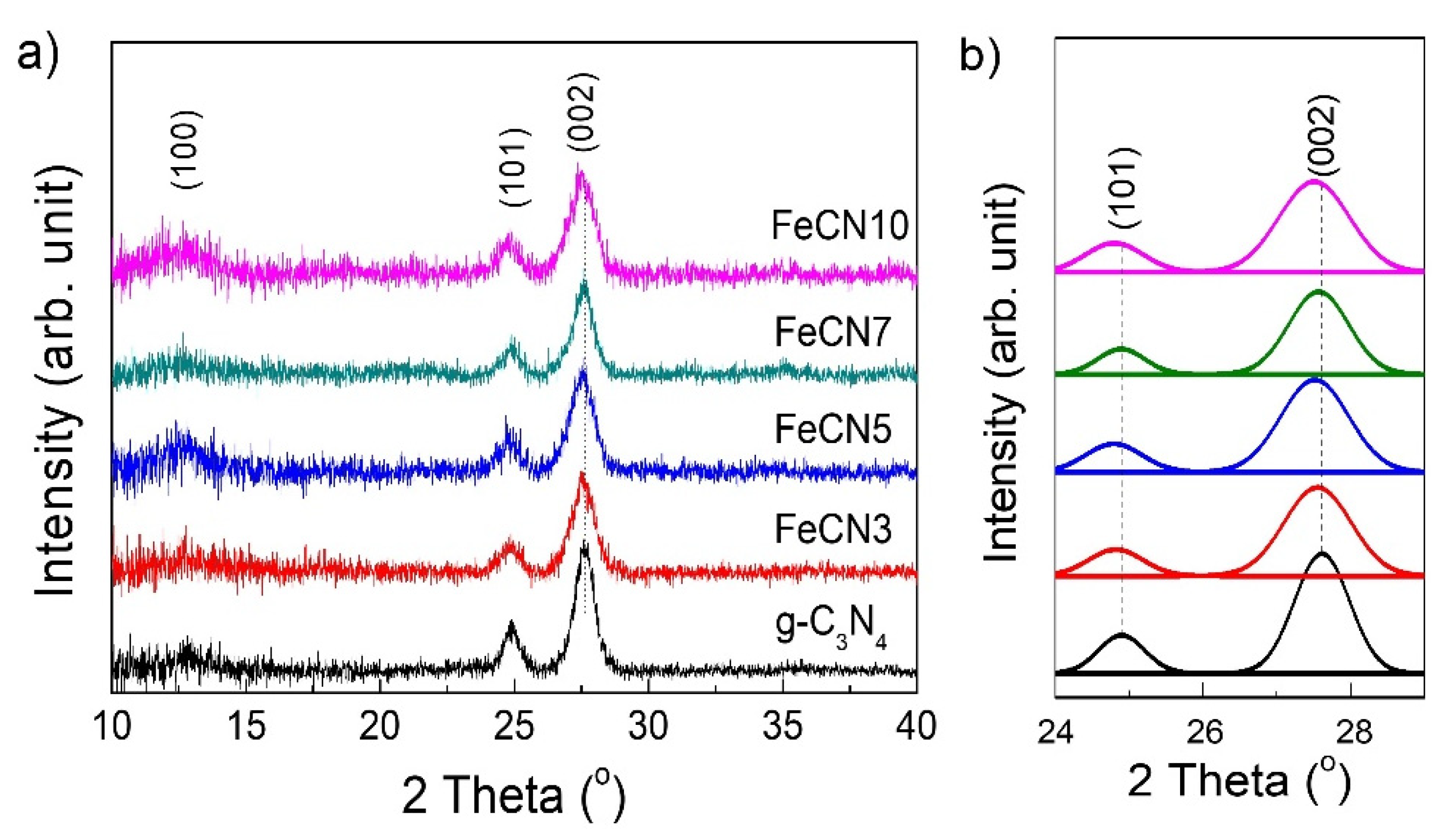
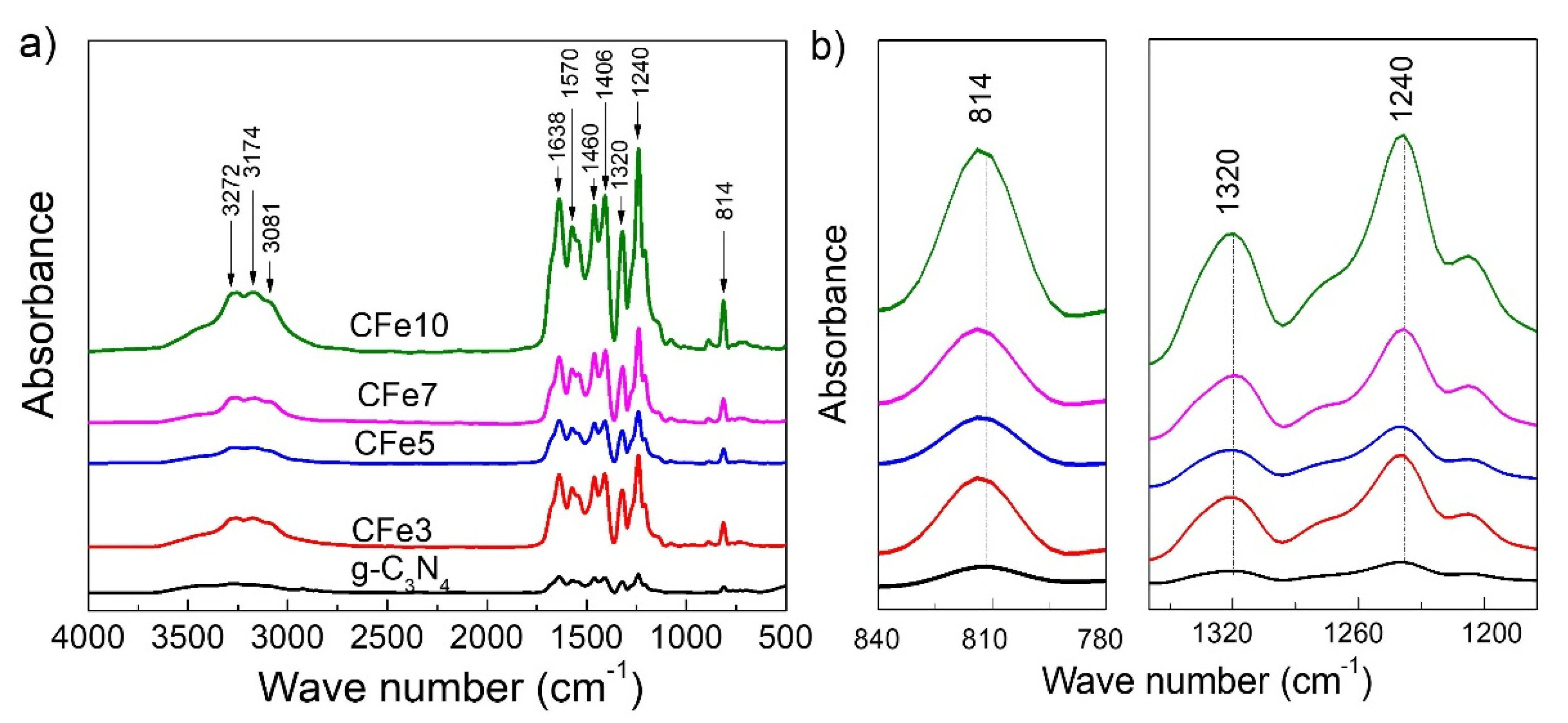

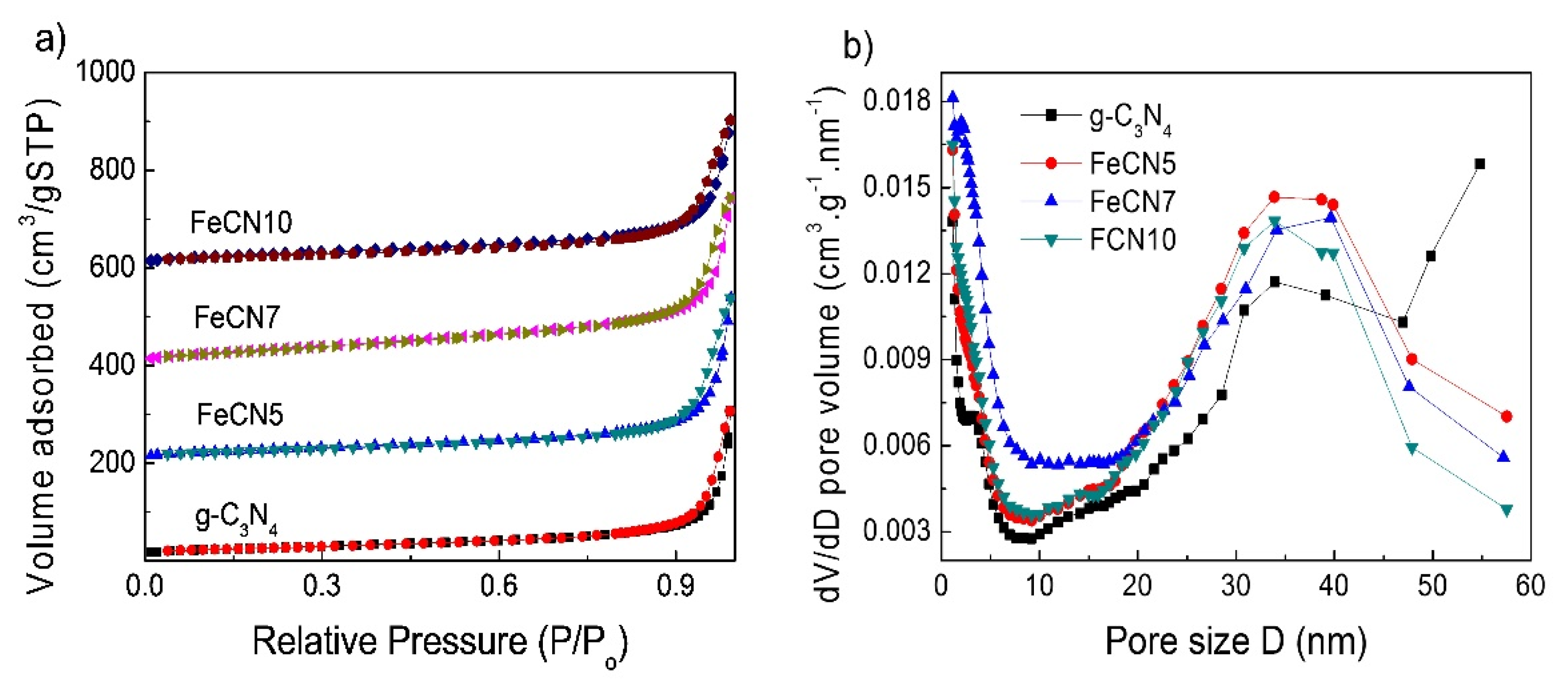
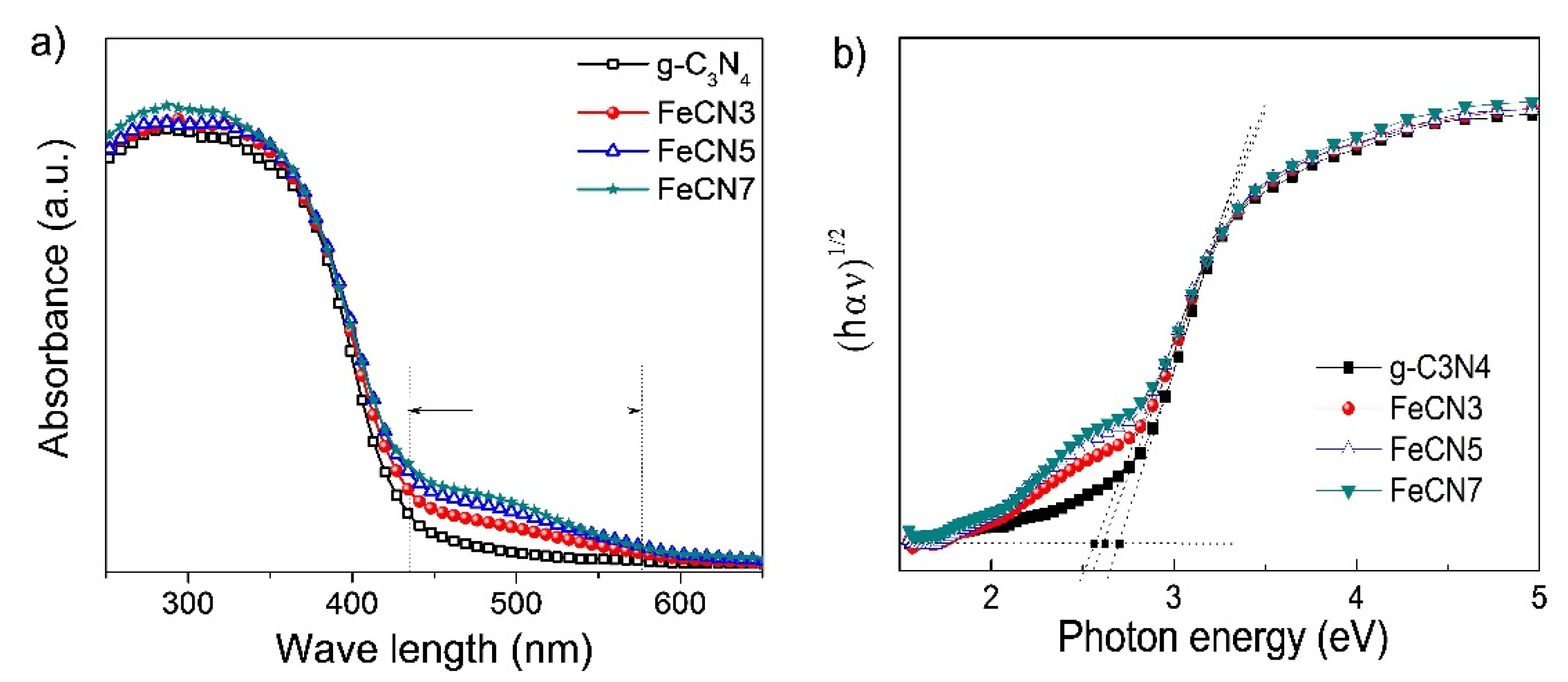


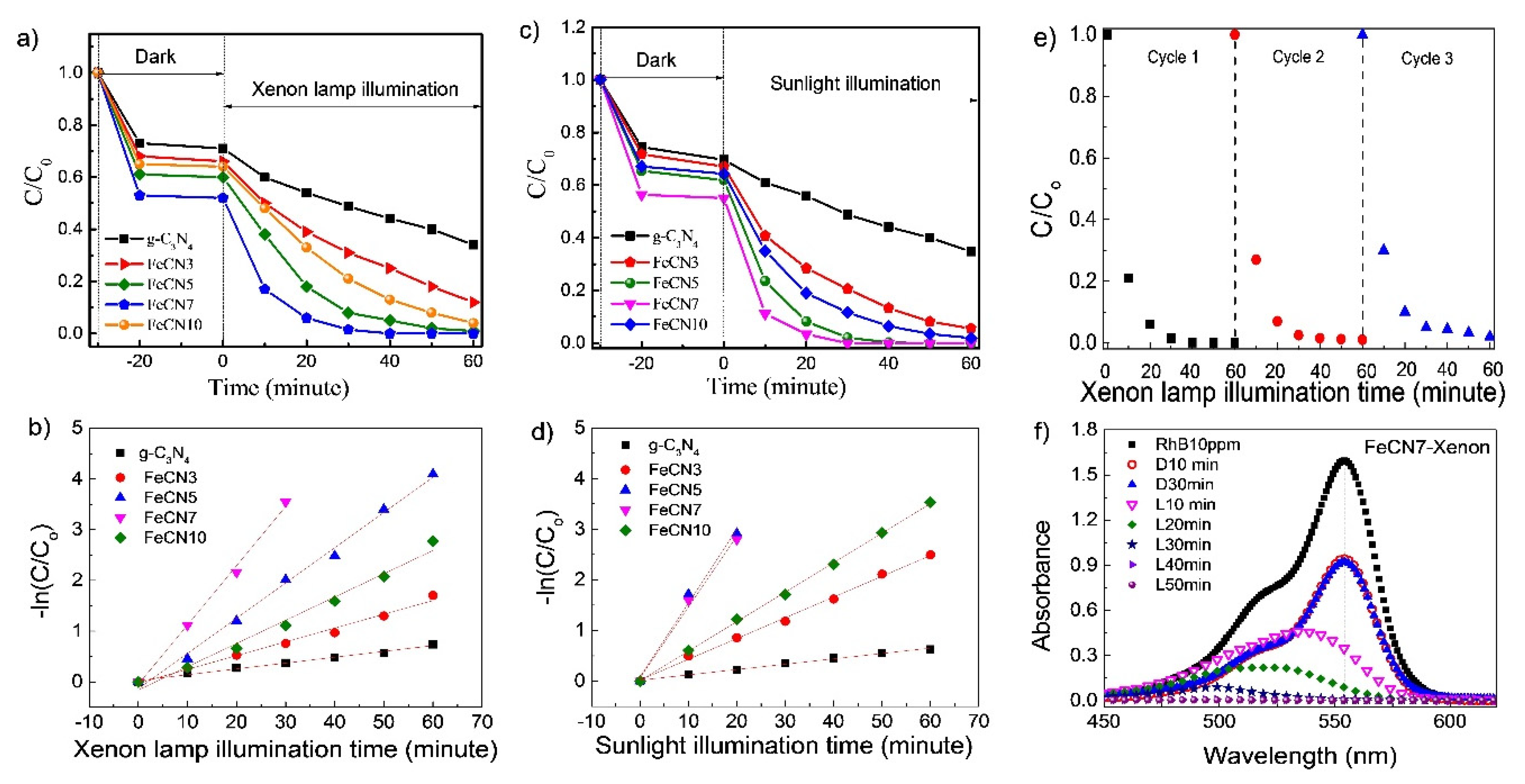
| Sample | g-C3N4 | FeCN5 | FeCN7 | FeCN10 |
|---|---|---|---|---|
| BET surface area (m2/g) | 91 | 100 | 132 | 104 |
| Pore volume (cm3/g) | 0.475 | 0.5223 | 0.532 | 0.465 |
| Pore size (nm) | 21 | 21 | 16 | 18 |
| Sample | g-C3N4 | FeCN5 | FeCN5 | FeCN7 | FeCN10 |
|---|---|---|---|---|---|
| Peak 1 (nm) | 431.73 | 429.72 | 429.15 | 429.2 | 429.11 |
| Peak 2 (nm) | 453.85 | 452.24 | 451.93 | 451.75 | 451.63 |
| Peak 3 (nm) | 488.88 | 488.27 | 487.77 | 489.11 | 488.48 |
| Peak 4 (nm) | 538.17 | 539.56 | 539.15 | 540.44 | 539.31 |
© 2020 by the authors. Licensee MDPI, Basel, Switzerland. This article is an open access article distributed under the terms and conditions of the Creative Commons Attribution (CC BY) license (http://creativecommons.org/licenses/by/4.0/).
Share and Cite
Nguyen Van, M.; Mai, O.L.T.; Pham Do, C.; Lam Thi, H.; Pham Manh, C.; Nguyen Manh, H.; Pham Thi, D.; Do Danh, B. Fe-Doped g-C3N4: High-Performance Photocatalysts in Rhodamine B Decomposition. Polymers 2020, 12, 1963. https://doi.org/10.3390/polym12091963
Nguyen Van M, Mai OLT, Pham Do C, Lam Thi H, Pham Manh C, Nguyen Manh H, Pham Thi D, Do Danh B. Fe-Doped g-C3N4: High-Performance Photocatalysts in Rhodamine B Decomposition. Polymers. 2020; 12(9):1963. https://doi.org/10.3390/polym12091963
Chicago/Turabian StyleNguyen Van, Minh, Oanh Le Thi Mai, Chung Pham Do, Hang Lam Thi, Cuong Pham Manh, Hung Nguyen Manh, Duyen Pham Thi, and Bich Do Danh. 2020. "Fe-Doped g-C3N4: High-Performance Photocatalysts in Rhodamine B Decomposition" Polymers 12, no. 9: 1963. https://doi.org/10.3390/polym12091963
APA StyleNguyen Van, M., Mai, O. L. T., Pham Do, C., Lam Thi, H., Pham Manh, C., Nguyen Manh, H., Pham Thi, D., & Do Danh, B. (2020). Fe-Doped g-C3N4: High-Performance Photocatalysts in Rhodamine B Decomposition. Polymers, 12(9), 1963. https://doi.org/10.3390/polym12091963





